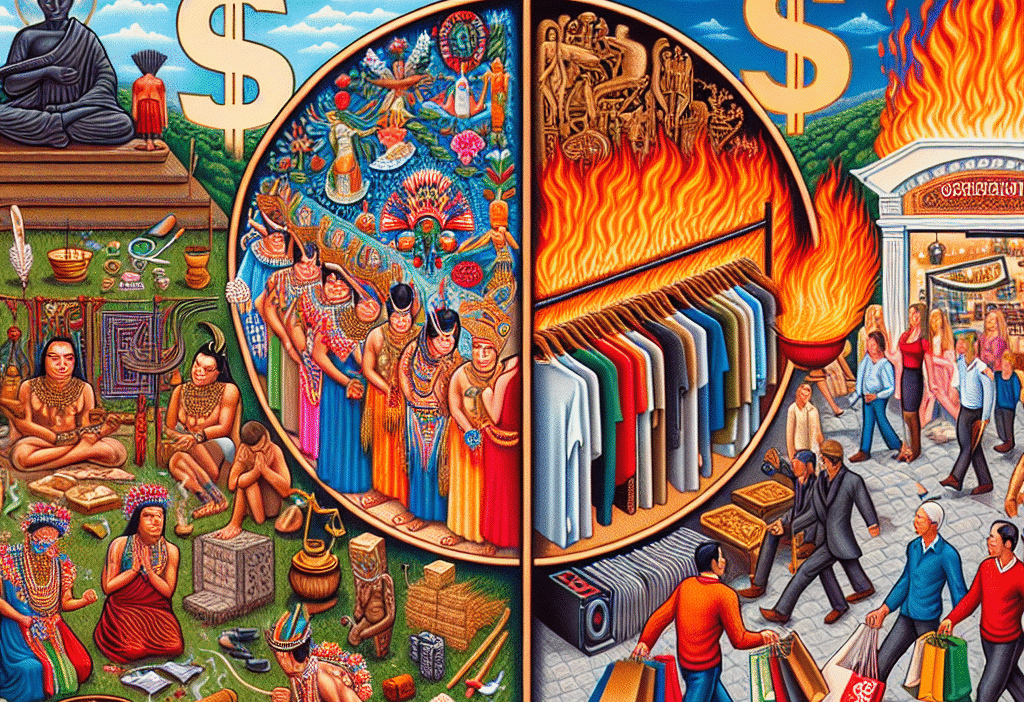Introduction
Have you ever noticed how cultural rituals, once sacred and steeped in tradition, are now increasingly intertwined with consumerism? 🙏 The phenomenon dubbed "Sacred to Sales" explores how some of our most cherished customs are being repackaged and marketed. From holidays that celebrate familial bonds to rites of passage that signify personal growth, consumer culture has cleverly commodified these moments into sales opportunities. This article delves into the complex relationship between cultural rituals and modern consumerism, providing insights into how religious celebrations, traditional festivals, and personal milestones have evolved into platforms for brands to engage with consumers, appealing to both emotion and identity.
Importance of the Topic
Understanding the commodification of cultural rituals is vital not only for consumers who seek authenticity amid rampant consumerism but also for businesses looking to establish deeper connections with their audience. As brands increasingly tap into the rich tapestry of cultural practices for marketing purposes, being aware of these dynamics can help individuals make informed choices while prompting businesses to navigate these waters ethically.
In this article, we will cover:
- The definition and context of commodification.
- Historical perspectives on cultural rituals.
- Case studies highlighting commodification in action.
- The psychological impact of this shift.
- Strategies for consumers and businesses in this landscape.
By the end, you’ll not only have a comprehensive understanding of Sacred to Sales: The Commodification of Cultural Rituals in Modern Consumerism but also a toolkit for navigating this complex terrain.
Understanding Commodification
What is Commodification?
At its core, commodification refers to the process of turning goods, services, or even ideas into something that can be bought or sold. This section unpacks how cultural rituals fit into this framework. Rituals often reflect social values and community identity; when these are commercialized, the essence and meaning can become diluted, leading to what many may perceive as "cultural appropriation."
Key Factors Contributing to Commodification
- Globalization: Increased connectivity means cultural practices are more visible and accessible, making them ripe for commercialization.
- Technology: Social media and e-commerce platforms have made it easier to market and sell products related to cultural rituals.
- Consumer Demand: People often seek meaningful experiences, leading brands to package cultural rituals in ways that resonate emotionally.
Historical Perspective: Rituals and Their Cultural Significance
To fully grasp how rituals have transitioned from sacred to sales, we should consider their historical context.
Ancient Rituals
From centuries past, rituals served as essential components of social life. Whether religious ceremonies, agricultural festivals, or rites of passage, they were often connected to specific cultural narratives and communities. For example, harvest festivals celebrated the bounty of nature, reinforcing social bonds and community identity.
The Evolution of Rituals
In the 19th and 20th centuries, many rituals became more formalized and commercialized. The introduction of advertising transformed traditional practices, with brands leveraging established customs to boost sales.
Example: Christmas
Christmas is a prime example of commodification. This once-religious holiday centered around community and spirituality has become a billion-dollar industry, dominated by gift-giving and consumerism. 🎄
| Aspect | Traditional Significance | Modern Commodification |
|---|---|---|
| Celebration of Birth | Religious significance (birth of Christ) | Retail sales (gifts, holiday decor) |
| Family Gatherings | Community bonding | Travel and dining expenses |
| Feast | Sharing and gratitude | Restaurant promotions and holiday menus |
Commodification in Action: Case Studies
Celebrating Festivals
Festivals like Diwali and Hanukkah have also seen shifts toward commercialization. 🎉 As brands align themselves with these rituals, many argue that the core values of these celebrations—community, spirituality, and tradition—are overshadowed by consumerism.
Example: Diwali
Diwali, known as the Festival of Lights, originally symbolizes the triumph of light over darkness. Companies now leverage the festival to promote luxurious decorations, special discounts, and even tech products.
Rites of Passage
Rites like graduations and weddings have also shifted significantly in meaning and purpose due to commodification. Weddings, once intimate unions, have morphed into elaborate events heavily tied to spending "the perfect day." 💍
Wedding Industry Statistics
- Average Wedding Cost: In the U.S., the average cost of a wedding is over $28,000.
- Market Growth: The wedding industry was projected to grow to $76 billion in 2022.
Psychological Impact: Why We Buy
Understanding the psychological underpinnings of this shift is essential for grasping how rituals are commodified. Many consumers are driven by a desire for connection, meaning, and nostalgia.
Emotional Connections
Rituals often evoke strong emotions. Brands exploit these feelings by embedding themselves in the rituals consumers cherish. Whether it’s a heartfelt advertisement during a holiday or a special product tailored to a rite of passage, the emotional resonance keeps consumers engaged.
Identity Formation
Cultural rituals help shape personal and collective identities. As brands latch onto these customs, they can influence consumers’ self-perception and social standing. Rituals become markers of identity, determining what it means to participate in a culture.
Navigating the Landscape: Strategies for Consumers and Businesses
As the landscape of commodification continues to evolve, both consumers and businesses must adapt.
For Consumers: Empowerment and Mindfulness
- Seek Authenticity: Engage with brands that honor the true essence of cultural rituals.
- Educate Yourself: Understand the origins of the rituals you participate in and how they have been marketed.
- Support Local Businesses: Often, local businesses respect and celebrate cultural rituals in authentic ways.
For Businesses: Ethical Marketing Practices
- Respect Cultural Origins: Brands must engage in ethical representations that respect the origins and meanings of cultural rituals.
- Engage with Communities: Collaborate with the communities behind these rituals for storytelling and representation.
- Transparency: Be clear about intentions. Are you selling a product, or are you genuinely celebrating a culture? 🤔
Conclusion
The commodification of cultural rituals stands at the intersection of tradition and modern consumerism, reflecting broader societal changes. As consumers become increasingly aware of the implications behind their purchases, businesses face the responsibility of navigating this landscape thoughtfully and ethically.
The key takeaway? Whether you’re celebrating a holiday or a personal milestone, you hold the power to choose how you engage with cultural rituals. Understanding the nuances of Sacred to Sales: The Commodification of Cultural Rituals in Modern Consumerism not only enriches your experience but empowers you to make informed choices.
Let’s Honor Tradition
Recognize that while commerce may drive many cultural rituals today, the essence of these practices lies deeper. By valuing authenticity over mere consumption, you can participate meaningfully in the rich tapestry of human culture. 💖
FAQs
1. What does "commodification" mean in this context?
Commodification refers to turning artistic, cultural, or social practices into commercial goods that can be traded or sold, often stripping them of their original significance.
2. How can I spot when a cultural ritual has been commodified?
Look for indicators such as excessive branding, insensitivity to the ritual’s origins, and an overt focus on consumer spending instead of communal or spiritual values.
3. Are there ethical ways for businesses to market cultural rituals?
Yes! Businesses should engage authentically with cultures, collaborate with community leaders, and emphasize respect and representation in their marketing efforts.
4. Can consumers impact the commodification of cultural rituals?
Absolutely! By choosing to support ethical brands and being mindful of the rituals they participate in, consumers can influence how cultural practices are marketed and celebrated.
5. How do I remain culturally sensitive while participating in rituals?
Educate yourself about the origins and meanings of the rituals, be respectful of traditions, and support local businesses that practice cultural authenticity.
By examining the intricate relationship between sacred traditions and modern selling strategies, we can better navigate our choices in this consumer-driven world. The balance of honoring the sacred while participating in commerce is a delicate dance—one that requires mindfulness and awareness from all sides.




